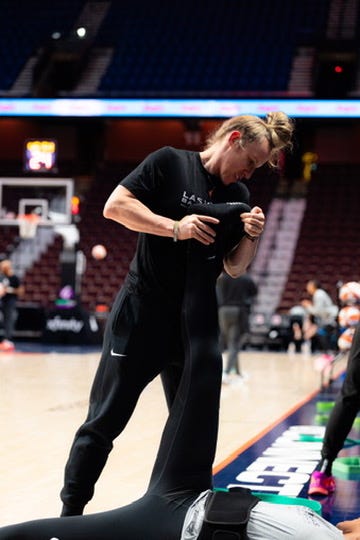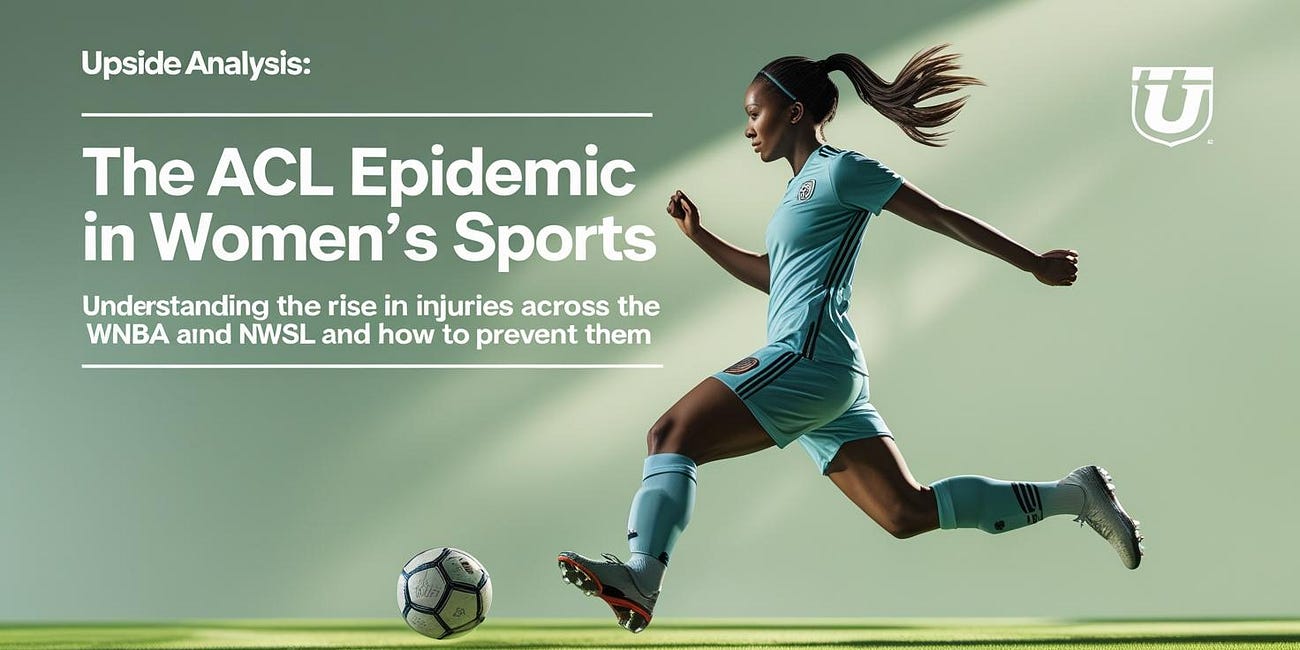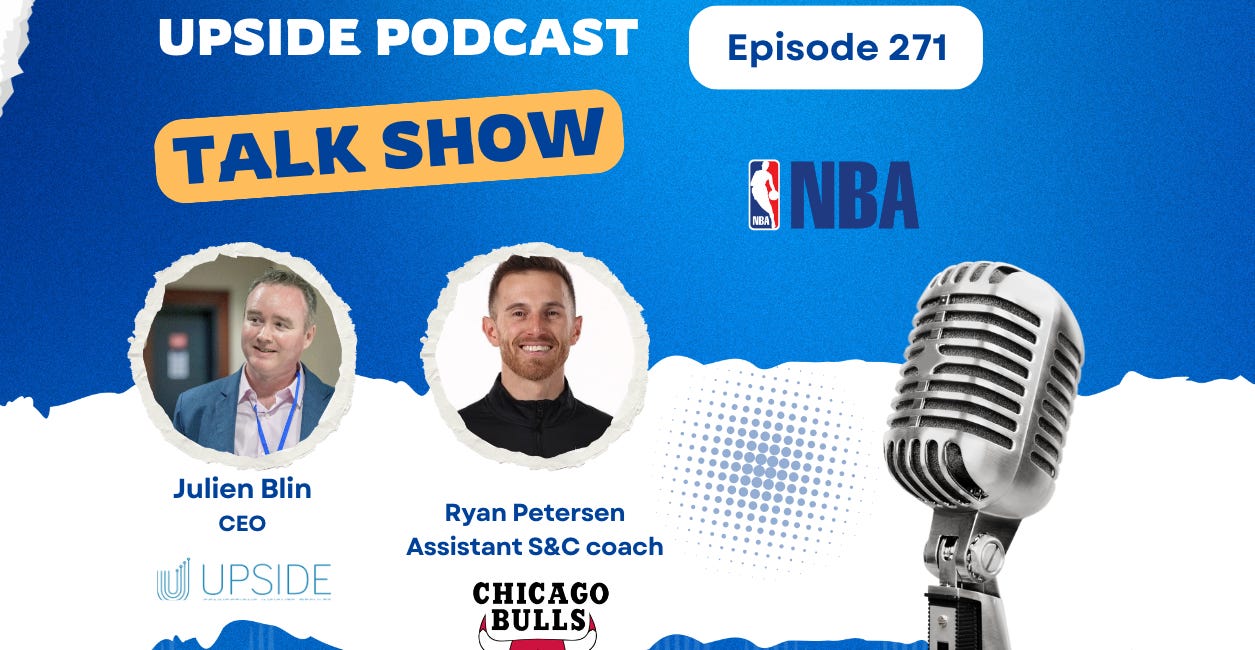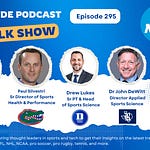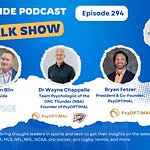Today we have the honor of interviewing Ciara Burgi, the director of health and performance at the Las Vegas Aces, a top WNBA team.
You can watch the video interview below by clicking on the Youtube link. You can also listen to the audio interview by clicking on the link at the top of the page:
📝Show Notes: In our interview with Ciara Burgi, Head of Health and Performance for the Las Vegas Aces, we explored her professional journey and what drew her into sports performance, the scope of her role and how it evolves throughout the season, and how she manages the balance between strength and conditioning, recovery, and rehabilitation in a demanding league. We asked how her department contributes to sustaining the Aces’ championship culture, the challenges of maintaining player health across a long, travel-heavy WNBA season, and the key differences in performance management between women’s basketball and men’s leagues. Finally, we discussed her vision for the future of performance science in the WNBA over the next five to ten years.
You can read the full transcript of the podcast interview with Ciara located at the top of this blog post.
Here are the quotes from the interview with Ciara:
Q1. Journey into sports performance
"My career has really been a succession of opportunities that I just said yes to. I started in strength and conditioning, but as a female I wasn’t sure what my longevity in that field would look like. So I decided to diversify, went to physical therapy school at Duke, and worked in outpatient PT for a few years. Eventually I got curious about higher-level sport—not because it was my dream to work in college or pro sports, but because I wanted to experience that environment. I ended up doing a fellowship at Duke in Division I athletics, which I loved because of the collaborative nature—you’re working with dieticians, mental health professionals, physicians, coaches, athletic trainers. After that, I joined the Houston Texans in the NFL, and later the Las Vegas Aces came calling. It wasn’t just about the director title, but about the opportunity to create a structure and culture within an organization already known for excellence. That curiosity and challenge drew me here, and now I’m in my second season with the Aces."
Q2. Role as Head of Health and Performance
"When I first arrived, it was three weeks before the season started. Honestly, it was survival mode—just all hands on deck, filling needs wherever they were. Last season was about making it through. This off-season was when we really started to build: figuring out what pieces of the staff fit, where we needed new ones, and shaping the culture. My role is both leadership and hands-on clinical, and as we’ve moved into my second year it’s become more about fine-tuning—onboarding new staff, refining systems, and making sure we’re heading the bus in the right direction. Each season feels like a cycle: first survival, then adjustment, then refinement, and eventually you get to that well-oiled machine."
Q3. Balancing S&C, recovery, and rehab
"The biggest shock moving from the NFL to the WNBA was how unpredictable the schedule is. In the NFL, you have a seven-day rhythm—Sunday games, Monday recovery, Tuesday off, Wednesday prep. In the WNBA, it’s eight games in 15 days across five cities, or 18 games in 36 days. You’re either stressed or recovering every other day. That density is the biggest challenge. So we keep our highs high and our lows low. Game days are high days—sometimes even high-minute players lift postgame just to keep the stress on the high day. Low-minute players follow a different schedule, but everything has to be individualized. With only 11 women on the roster, individualization isn’t just ideal, it’s required—because a low-minute player can suddenly become a high-minute player overnight. So every player’s stress-recovery cycle has to be carefully mapped across microcycles of 7, 10, or 12 days. It’s not easy, but it’s the only way to keep them always ready to perform."
Q4. Contributing to the Aces’ culture of excellence
"Our organization is surrounded by excellence. Our president, Nikki Fargas, has championship expectations. Becky Hammon is a champion. We have four potential future Hall of Famers on our roster. When you’re in that kind of environment, you can’t help but rise to the occasion. Mediocrity just isn’t tolerated here. At one point this season we were .500, and you would have thought we were 0–30—that’s the standard. For us in performance and health, our job is to make sure the athletes have everything they need to succeed. The culture isn’t about ‘win at all costs,’ it’s about demanding excellence in a healthy way. The belief in the locker room never wavers, even during tough stretches. That resilience, paired with high expectations, is what sustains a championship culture."
Q5. Challenges of the WNBA schedule
"The density and intensity of the WNBA schedule is nothing to take for granted. In school we learn about recovery timelines for hormones, tissues, and systems—but in this league, nothing ever fully returns to baseline when you’re playing every 48 hours or back-to-backs. So you have to throw out the rigidity of textbook ‘optimal.’ It becomes about weighing risk and reward: what’s the best low-risk, high-reward intervention we can do today that sets us up for three days or three weeks down the line? You have to zoom out, plan ahead, and know what the next 14 days look like while still being present in the moment. There’s no perfect answer, only the best decision for that stretch of time. And with a small roster and staff, we don’t have an excuse not to be individualized. If we’re not having those detailed conversations about each athlete, we’re not meeting the standard."
Q6. Differences between women’s and men’s leagues
"One of the biggest differences is roster size. In the NFL, with 53 players, individualization is limited. In the WNBA, with 11 players, it’s mandatory. The other big difference is culture. Football is very militant—yes sir, yes ma’am, follow the program. Women’s basketball is not that culture. Our players have had to make it overseas, often without resources, so they’ve become incredibly educated about their bodies and how to care for themselves. They come with strong opinions and expect collaboration. They’ll share what works for them, and they expect us to listen and meet them halfway. It’s not that they’re less disciplined, it’s that the sport’s culture is built on self-reliance and collaboration. If you come in with a dictator-style, militant approach, you won’t succeed in women’s basketball. It requires curiosity, adaptability, and respect for how the athletes have learned to survive and thrive."
Q7. Future of performance science in the WNBA
"The future isn’t just about high-budget technology. The lowest hanging fruit is still the basics—nutrition, sleep, facilities, recovery resources. Not every WNBA team even has its own practice facility or provides consistent post-game meals. We just got charter flights last year. Until the basics are equalized across the league, technology is secondary. My hope is that over the next few years, the CBA and growing resources will level the playing field so every athlete has access to those essentials. Then, once the foundation is solid, we can start layering on the advanced tech—AI-driven injury prediction, biomarker tracking, menstrual cycle monitoring, and other innovations. But if I have $100,000 right now, I’m not buying an AMS. I’m making sure our players have meals and the basics. Do the basics extraordinarily well first, then build toward the future of performance science."
You may also like:
📚 Upside Analysis: The ACL Epidemic in Women’s Sports: Understanding the Rise in Injuries Across the WNBA and NWSL and How to Prevent Them
Anterior cruciate ligament (ACL) injuries remain a critical issue in elite women’s sports—particularly in the WNBA and NWSL. These injuries not only sideline athletes for 9–12+ months, but they also carry performance, psychological, and career longevity consequences. This report explores injury prevalence, evidence, case studies, prevention strategies, …
🔥Upside Chat with Female Sports Experts: Allison Schmitt (Olympic Champion),Mélanie Pauli (Swiss Football), Dr Christy Fernandez-Cull, PhD, CEO (DaVinci Wearables)
Today as part of our continued effort to bring more awareness on female athletes, teams and associated trends related to female athletes, we have the honor to interview a group of female sports performance experts:
🎙️ Upside Chat with Ryan Petersen, Assistant S&C coach, Chicago Bulls (NBA) on His Background, Approach Towards Training, Innovation, Recovery, and More.
Today we have the honor of interviewing Ryan Peterson the assistant S&C coach for the Chicago Bulls, a top NBA team.




